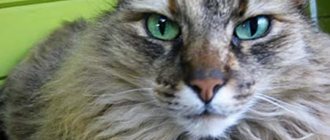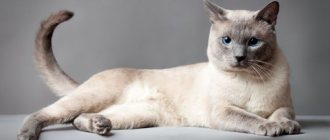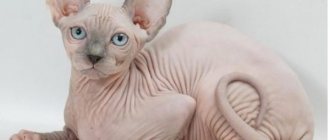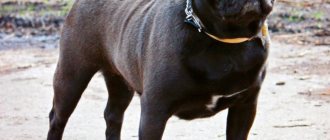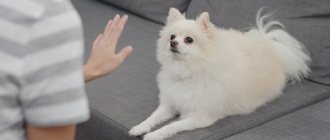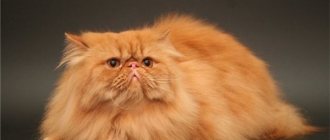Color-point cat breeds: description and color varieties
Acromelanic coat color in cats or, in other words, color point has now become widely known.
Among pet lovers, kittens with such fur are especially valued, and they look very impressive. Previously, this color was characteristic only of the Siamese cat breed. Today, thanks to the hard work of breeders, almost every second breed in the world is a carrier of the color point gene. Cats with this coloring always attract the attention of others. All thanks to the darkened limbs (ears, muzzle, paws and tip of the tail). The color-point color, that is, the Siamese, as it is often called, has many varieties. The tone of the coat color on the limbs (“points”) can be warm or cold, just like on the body. Those who want to get a kitten with a similar color will have a hard time making a choice, because there are many color options.
- 1. Seal point - classic Siamese. It is very similar to the fur seal's coloration: the markings are dark brown and the body is a light warm shade.
- 2. Chocolate Point is a very rare color, most of the coat is ivory, and all the markings are chocolate.
- 3. Blue point - with this color, all marks are pale blue.
- 4. Chocolate smoke point is another rare color. In this case, most of the fur is ivory, the tips of the hairs are smoky, and the rest (markings on the limbs) are chocolate.
- 5. Lilac point - considered a particularly rare color, in this case the markings are lilac (blue with a pink sheen).
- 6. Lynx point - very similar to the color of a lynx, with striped points. There are red, purple, cream, caramel, tortoiseshell and others. The limbs are darker than the rest of the body, but a striped pattern may appear on the main surface of the cat's coat as he ages.
- 7. Cinnamon point - similar to ivory color. The points are cinnamon colored. The paw pads and nose can be brown or pink.
- 8. Fawn point - the color of the coat on the body is light cream, on the limbs - beige. The nose is light pink, as are the paw pads.
- 9. Tortie Point - Generally similar to the Tortoiseshell Point color, where the color of the markings is a soft cream shade with red or cream spots.
- 10. Red point - the markings have a pronounced red color, and the color of the rest of the coat is bluish with a pink sheen.
- 11. Cream point - all points have a delicate cream shade.
Thai cat: breed description, standards
Thai cats have a good character. They are unusually smart, easy to train, clean and quite sociable. Like any creature, they have not only good qualities, but also bad ones. If they are treated with respect, they will behave well.
As for appearance, there is a standard:
- The standard is considered to be medium-sized animals, weighing from 5 to 8 kg. They should have a compact, muscular body with a broad chest and be gracefully built.
- In accordance with the World Cat Federation (WCF) standard, the animal's head should be rounded with an extended forward muzzle, similar in appearance to a wedge. The chin should not protrude forward. The norm is round cheeks, not too plump.
- The cat should have a short neck, not a long one.
- The eyes are large, almond or lemon shaped, blue to blue in color.
- The ears are wide and length is medium. The tips of the ears are slightly rounded.
- Legs are strong, with developed muscle mass. The length is average, corresponding to the size of the body. The size of the paws is small and round.
- The length of the tail is commensurate with the proportions of the body.
- The coat is short, thin, without undercoat. It should be slightly adjacent to the skin and feel smooth to the touch. The standard coat color is acromelanic.
Be sure to read:
Black and white cat: features, classification, types, breeds, how to breed correctly
The colors of the “Thais” are varied, as are their shades. They can be plain, striped or spotted. One of the main features of the color is a dark “mask” located on the muzzle. Individuals with a bright contrast of points enjoy great success at the exhibition.
Scottish Blue Point cats
The color of blue point Scottish cats (translated from English as “blue-point” means “blue dot”) is very beautiful. These are completely unique shades of light fur - the main color and shading on the paws, muzzle, ears and tail. Many people want to get just such a cat, because she is fabulously cute.
The blue point color is associated with the phenomenon of acromelanism - the dependence of the intensity of coat coloring on temperature: in places where the body temperature is higher, the coat is lighter, and vice versa. While colorful kittens are in the mother’s belly, they are completely light, because their body temperature is uniform. But within a few days after birth, Scottish Blue Point kittens begin to darken their paws, tail, face and ears due to the fact that the temperature of these parts of the body is lower than the rest. This effect is associated with the action of the enzyme tyrosinase, which is responsible for the synthesis of pigments. By the way, for the same reason, colorful cats can change color slightly depending on the air temperature - sometimes darker, sometimes lighter. In addition, this color changes with age.
Blue point color standard
A straight-eared or fold-eared Blue Point Scottish cat should have a blue mask on its face and the same markings on its ears, paws and tail. The rest of the body is almost white: without markings or patterns, blurred spots and yellow tones. All this is considered a disadvantage.
A good point color that will last a lifetime is quite difficult to obtain. Small kittens often have high-quality coloring that matches the standard, but as they grow older, the body may darken, which is a big disadvantage.
The ideal point color works well when both parents of the kitten are also points, and not in the first generation. Conversely, there is a greater chance of getting a darkened body if the parents were of a different color, for example, solid (solid).
The eyes of a blue point cat, as we have already said, are blue. The darker, more saturated, “deeper” the color, the better. Cats with light eyes (and often they are not at all expressed, grayish) are valued less.
Colories with decent eye color often have disgusting coat texture and a rustic appearance. The British often have weak bones, the Scots have short, problematic tails and ears that are not laid back well enough. These disadvantages are related to similar problems with shaded colors, which are most often used to produce color points. Yes, there are already some British people with decent hair and decent type, but there are only a few of them. As well as in the colorful colors worthy of the Scottish ones, there are only a few. British colors, obtained from blue, lilac, and patterned animals, most often have good bone and coat. In some places there is even a good contrast, but for the most part they have an extremely pale eye color. Scottish breeds bred from colored stock are also pale-eyed. They have a positive chance only if they are obtained from stable lines imported at different times from the USA and Canada. Local stock bred from the British will produce British-like variants with all the characteristic nuances.
Anomalies and features inherent in the British Bluepoint
The term color point is translated as colored dots (marks). The color of a cat's fur and iris is determined by the presence of a special coloring pigment (melanin), which is synthesized under the influence of tyrosinase (a copper-containing enzyme) from the amino acid tyrosine. The production of the enzyme is supervised by the C (Color) gene.
Albino cats are often deaf
The Siamese gene (cs) is formed in a similar way, when the main gene C is damaged. The only difference is that the enzyme that oxidizes the amino acid acquires thermosensitive properties. It is activated and produces melanin only at certain low temperatures; at higher temperatures it does not manifest itself at all. This phenomenon is scientifically called acromelanism.
We suggest you read: Is it possible to give milk to adult cats and kittens?
This is how the Siamese thermal effect is obtained, when the peripheral remote (cold) areas of the body with a slightly lower temperature are colored. At the same time, the pigment is almost not synthesized in the remaining warmer areas of the animal’s body. The Blue Point cat is actually gray (blue), but its color appears only on the ears, face, tail and paws.
The Siamese color can appear in varying degrees of intensity.
Newborn kittens are light, almost white, because it is warm in the womb of the mother cat, the temperature is the same and melanin is not produced. The point coloration in babies does not develop immediately. First the tail darkens, then little by little the ears, and only then the nose and paws. The mask on the face is the last to darken; during the first two months of life, only one nose of the kitten may be colored. Points begin to appear literally a few hours after birth and are finally formed only by a year, or even later.
Pointed kittens are always born completely white.
We live in a private house and by the color of our Siamese cat we can safely judge the current time of year. In the summer, when it is warm and she often walks outside, her fur becomes lighter and even the dark areas on her face, paws and tail become less bright. In winter, the pet gets very dark, because the floor is cold, and that is where she most often lives, although she tries to lead a sofa lifestyle.
Blue point color genetics
Point belongs to the black series of colors, because, from the point of view of genetics, blue is nothing more than a diluted, or rather rearranged, black pigment. But blue coat genes B (black series) and d (dilution gene) alone are not enough to get a point kitten. A couple more recessive cs genes are needed, which displace the pigment into the marking area.
The ancestors of the Points are Siamese cats, which is why the color is also called Siamese. In Thailand it is considered sacred because... he was taken out by the monks in the monastery.
Today, among Scottish cats, the color gene cannot be called so rare, but breeders often value its carriers higher than solid blue cats. There are even entire nurseries that specialize in the reproduction of Point cats.
You can get a point cat even if both parents, for example, are gray (that’s what people call them, although they are actually blue). The main thing is that they are carriers of the desired gene. But even if they carry this gene, the chance of having a colored kitten is 25%. It happens that the color gene appears after 2-3 generations. For example, the kitten’s great-grandparents were colorful, but the gene did not manifest itself in the form of color in the parents. At the same time, two color point parents cannot produce a kitten of a color other than color point.
Features of mating British blue point dogs
The bluepoint color is quite difficult to breed, since the cs gene is recessive (suppressed). Only when both producers (male and female) have such pigment colors, the kittens in the litter will be guaranteed to be pointing only. Parents with smooth, monochromatic hair who are carriers of the cs gene can also produce children with Siamese pigmentation, but with a 25% chance.
The genetics of color point colors are very complex.
Once upon a time, my parents had a Siamese cat, Sima. She was extremely fertile and regularly gave birth to offspring of 5-6 kittens. The babies always turned out with Siamese colors, completely regardless of what their father was like. But they often had defects in coloring. Some kittens had white spots on their paws and tail, and this was immediately noticeable, since the process of darkening the fur began quickly.
We invite you to read: Scottish Fold - a suitable pet for a city apartment
Strabismus in point cats
Cats of any point color (and there are not only blue, but also seal point, lilac point, lynx point and other variations) can experience convergent strabismus, which is characteristic of cats of the Siamese, Thai, Oriental and Burmese breeds. This defect, geneticists believe, is a byproduct of the action of the cs point gene.
Often in point cats you can find a violation of the projection of the optic nerves: part of the visual pathways from the eye goes to the side of the brain opposite to the norm. To compensate for this feature, strabismus appears, which allows the cat to build the correct visual picture.
However, there is an opinion that just one pair of cscs genes is not enough for the development of strabismus: additional genes are needed that lead to such a disorder. That is, to say that most point cats suffer from strabismus is incorrect: the majority of Scots point cats, in fact, do not have this problem.
Blue point color and character
There is an opinion (not a proven fact) that the Blue Point Scotsman is a cat with character. The fact is that the blue colors of the Scots were originally obtained from British cats, known for their temper. Modern Scottish Folds and Blue Point Scottish Straights are somewhat similar in character to the British: they are independent, willful, and can be aggressive if they don’t like something. However, the degree of expression of these qualities depends on the presence of British cats in the immediate family. If there are a lot of British people in the document, you should expect a tougher character, and vice versa. However, British genes will still be softened by Scottish ones, so such cats are more sociable and kinder than their British counterparts.
Briefly about the British breed
The British cat breed is considered one of the most ancient; the first mentions of domesticated cats and their images, visually reminiscent of modern Britons, are found in handwritten books of the 7th-8th centuries. However, the breed was officially recognized only at the end of the last century.
British cats became especially popular in the 19th century
Cats of the British breed are distinguished by a large, massive and slightly squat physique . The average weight of males is usually about 7–8 kg, but sometimes individual individuals can reach 10 kg. Females are rarely heavier than 6 kg; they are considerably smaller and more graceful. The British have a muscular, stocky, harmoniously sculpted body with a wide sternum, a massive shoulder girdle and back, as well as strong, thick, slightly short legs. The forehead-shaped, round head with large eyes and wide-set ears is firmly set on a short but strongly developed neck. The chin is well defined, the nose is short and quite wide, and the whiskers are clearly visible on the voluminous cheeks. The tail is of medium length, proportional to the entire body of the animal, thick at the base, tapering towards a rounded tip.
British cats have a massive and strong build.
A purebred Briton is always distinguished by a short and very thick soft coat that does not lie close to the body, plush to the touch, with a densely packed, high-quality undercoat.
Caring for point cats
In general, care for point cats is the same as for cats of other colors. But it has its own characteristics.
Point cats cannot be cut or shaved: this leads to the appearance of darker areas of the coat. In the photo below you see the “panties” of a point cat, which formed after shaving before sterilization. This feature of this color, of course, does not mean that a Point cat cannot be operated on: a mark on the stomach does not make the animal less beautiful, because it is practically invisible. But, if you trim your cat's entire hair or in prominent places, or shave it, this can cause it to become dark throughout the body, and this will ruin its appearance.
Inept use of a fruminator when combing can also lead to bad consequences, because... With this tool it is easy to damage and cut off hairs, resulting in the undesirable effect of darkening the fur. If you do not know how to use a furminator, it is better to opt for a special paw for combing cats.
Also, the color of the point, as we said above, reacts to the ambient temperature: the lower it is, the darker the marks, and vice versa - in the heat, many cats become significantly lighter. Accordingly, don’t be surprised if your cat looks a little different depending on the time of year. The ideal temperature for keeping points is +25 degrees.
It is worth considering that the blue point color is a light color, and therefore easily soiled: dust and dirt in the house, settling on the fur, will spoil the appearance of the cat. Even if she is washed regularly, you will notice that the color becomes more interesting after a bath. This statement is not a call to endlessly bathe your pet, but advice on how you can improve the color if you suddenly notice that it has worsened. If the cause was contamination, advice will help. Although there are many other reasons for the deterioration of color point colors.
To improve the color, you can bathe Blue Point cats whose bodies are not light enough with special lightening shampoos. However, if the cat’s markings, on the contrary, are weakly expressed, then there is no need to lighten the fur further. Then you can choose any shampoo based on the problem (if any) or a basic one. We are talking about professional shampoos. It is better to avoid mass-market shampoos.
Features of keeping and caring for the British Blue Point
The original heat-dependent point color imposes some restrictions on the living conditions of such cats. First of all, it is extremely important to maintain the optimal temperature in the room; it should be between 25–28 °C. When there is a sharp cold snap, the cat’s coat darkens; in extremely warm temperature conditions, the marks lighten and become almost invisible.
We suggest you read: How to choose an Alano puppy
Some foods negatively affect the color of the coat, causing it to darken or yellow:
- seaweed and any seafood containing high amounts of iodine;
- carrots (raw and boiled);
- buckwheat grain;
- beef;
- liver and other foods rich in copper.
It is better to feed British Blue Point cats with special food for Siamese cats
If a predisposition to color changes is noticed, then it is better to opt for specialized food for Siamese cats.
If possible, traumatic damage to the skin and operations should be avoided, since the hair on the damaged area of the skin grows much darker than on the rest of the body. The scarred tissue is colder, which provokes the synthesis of the coloring melanin. This is why pointing cats always have their nails trimmed in a timely manner (at least once every 2-3 weeks) and their ears cleaned (at least once a week).
Particular attention is paid to the care of the coat (applies to long-haired Britons), which must be thoroughly combed daily. The resulting tangles on a neglected animal will have to be cut off, and the newly grown coat will be darker.
If pointing cats are not kept correctly, their fur will darken.
After a sterilization operation, our Siamese cat developed two dark spots on her stomach, exactly where the incisions were. Moreover, light, almost snow-white areas appeared near them. Almost two years have passed and the color has not recovered.
The rest of the care is standard and consists of the following procedures:
- brushing your teeth (every 5–7 days);
- rubbing eyes (daily);
- bathing using special shampoos (1–2 times a year);
- vaccination (annually);
- prevention of parasites: against worms - suspensions, tablets, etc.;
- for fleas - collars, drops on the withers, shampoos, etc.
What does the Blue Point color mean?
An unusual coloring called Color Point has long been characteristic only of the Siamese breed. Its main difference is the presence of color only in certain places, the so-called points.
The shade appears only on the tail, ears, paws and nose, the rest of the cat’s body remains white.
At birth, babies are completely white, and only then the tail gradually darkens, then the ears, and lastly the paws become colored and a mask appears on the face.
Variations
In addition to the classic blue point, today there are several more variants of this shade:
- In Blue Tabby Point , the markings on the paws and face are not uniform, but striped (tabby). On the forehead the stripes form the letter M.
- The Blue Ticked Point is a recent development and is very rare. It originated from Abyssinian cats and is distinguished by the fact that a ripple effect is visually created on the body, making the fur look like the skin of a rabbit or chinchilla.
- In the Blue Cream Point , blue-gray markings are evenly mixed with cream. The nose can be either dark or pink.
- The blue tortie point has a tri-color tortoiseshell pattern. This is a chameleon color that changes its appearance throughout its life. Each cat of this shade is unique due to the arrangement of bluish-cream markings.
Blue cake point
A Brief History of Breeding Cat Colors
Initially, all cats had variegated colors, which allowed the animals to remain unnoticed in the forest. Human intervention has made their color, by which we mean the color of the coat and various patterns on the skin (stains, all kinds of spots, stripes, etc.), extremely diverse. As a result of crossing individuals with certain characteristics, offspring of the desired color appeared. To consolidate the result obtained, only these animals were used in future breeding work; all others were excluded from the breeding process.
There are a lot of colors of cats bred
